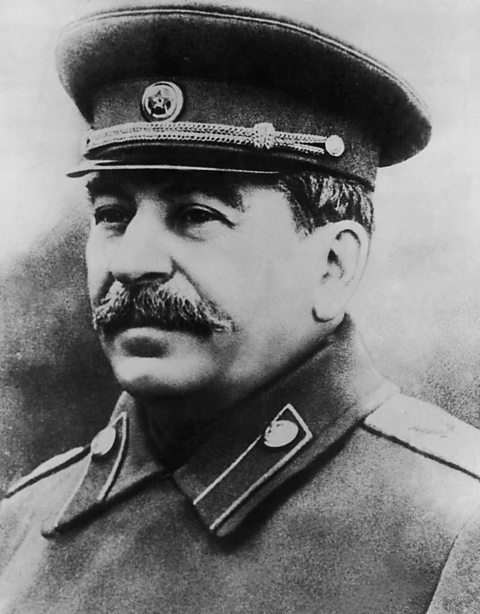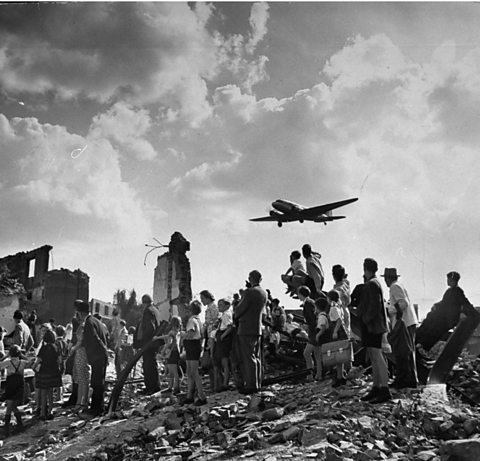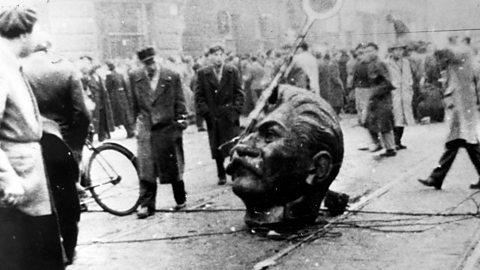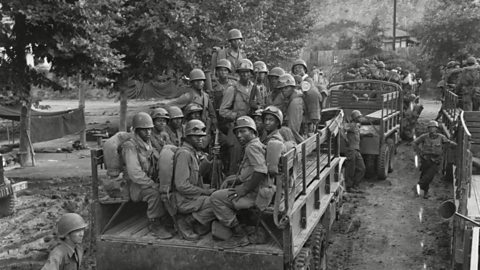Divided Berlin
The first major crisis of the Cold WarThe political tension and competition for power that existed between the communist East and the democratic West after World War Two. The two sides did not ever go to war. was over the city of Berlin.
Berlin had been divided into four sectors (French, British, American and Russian) following the war and each country was responsible for their own sector.
Berlin however, was 100 miles inside of the Russian zone.
This meant that the Allies had to travel through the Russian zone of Germany to get to their section of Berlin.
By 1948, the Western zones of Germany were recovering mainly as a result of Marshall AidFinancial assistance given by the USA to European countries in 1948 to help them rebuild after World War Two and to stop the spread of communism..
However, the Russians had removed a large amount of resources from their zone.
As a result, living conditions in the Russian zone were much worse than in the other zones.
What caused the Berlin blockade?

- Using money from Marshall AidFinancial assistance given by the USA to European countries in 1948 to help them rebuild after World War Two and to stop the spread of communism., the Allies were helping the Germans to rebuild their economy.
- Stalin was worried that the West would take advantage of their stronger position to unite all their zones and eventually take over the eastern part.
- The Allies introduced a new currency, the Deutschmark, that would be used throughout their zones in Germany.
- Britain, France and the USA joined their zones together to create Trizonia. Stalin was angry at being left out of this.

Events of the Berlin blockade
On 24 June 1948, Stalin cut all land access to Berlin for the Allies, citing вҖҳtechnical difficulties'.
This became known as the Berlin blockade.
Stalin did not intend to risk war over Berlin, he likely wanted to show that the Soviets also had power in Germany which could match the demonstrations of economic power and unity that the West had just shown.
He was using the blockade to prevent any further Western moves in Germany and hoped that they would abandon the Western zones of Berlin.
Question
How did the Allies respond?

The Berlin Blockade was the first serious clash between the members of the former Grand AllianceDuring World War Two, the USA, Britain and the USSR formed the Grand Alliance against Germany and Japan. This alliance brought together countries with different ideologies - Britain and the USA were capitalist and the USSR was communist., and from this point, it was very clear that the Cold WarThe political tension and competition for power that existed between the communist East and the democratic West after World War Two. The two sides did not ever go to war. had begun.
The Western Allies were not prepared to risk armed conflict with the Soviets to open the way to West Berlin.
They decided that their sectors of Berlin would be supplied by air.
This became known as the Berlin Airlift and it lasted for 11 months until the Blockade was lifted in May 1949.
The Berlin blockade in numbers
- 24 June 1948, Stalin cut all land access to Berlin for the Allies.
- West Berlin only had enough food for 36 days.
- There was rationingThe system of limiting people's access to things that were difficult to get during World War Two. People were allowed limited amounts of food, clothing and soap during the war. This meant that there would be enough goods for everyone. amongst West Berliners.
- Planes landed every 2 minutes.
- In total, 2 million tonnes of supplies were airlifted in.
- 101 men died.
- The blockade ended on 12th May 1949 after 324 days.
Consequences of the Berlin airlift and impact on relations

- The Berlin airlift was a propagandaThe spread of ideas, often one-sided, designed to influence people's opinions. defeat for the Soviets and a great boost for the West.
- NATONorth Atlantic Treaty Organisation - a military alliance of Western powers originally set up (in April 1949) to provide a counterforce to the Soviet armies of Eastern Europe. was formed in April 1949 for the common defence of Europe.
- It convinced the West that Germany could not be united and declared their zones a separate state. In May 1949, the German Federal Republic вҖ“ West Germany вҖ“ was set up. On October 1949, the German Democratic Republic - East Germany вҖ“ was created from the Soviet zone. Germany was now divided into two states.
- Berlin remained a flashpointDescribes a location, event or time at which violence or hostility can suddenly arise. in east-west relations.
- The crisis highlighted the dangers of superpower conflict. It also showed the limitations. The Soviets did not use their larger army; the US did not use their atom bombA nuclear weapon that releases a huge amount of energy by splitting atoms. They can cause enormous amounts of death and damage when dropped on an area. .
- containmentAn American policy to try and stop communism from spreading to other countries. was proven to have worked - West Berlin had remained under a capitalismA system of running a country where most businesses are owned by private companies or individuals, not the government. government.
- The Warsaw PactA collection of 12 communist countries that agreed to defend each other if one of them was attacked. established by Soviet Countries - agreed to defend each other if one was attacked.

NATO - Warsaw Pact
| NATO | Warsaw Pact | |
|---|---|---|
| Formed | April 1949 | May 1955 |
| Aims | To resist an attack by the USSR on the USA or its Allies in Western Europe, based on the principle that an armed attack on one of its members was an attack on them all. | To resist an attack on the Soviet bloc by the USA or its NATO allies. |
| Members | USA, UK, Canada, West Germany, Portugal, France, Belgium, Holland, Denmark, Iceland, Italy, Luxembourg. | USSR, Poland, Hungary, Czechoslovakia, Bulgaria, Romania, East Germany, Albania. |
Test your knowledge
More on International relations, 1945-2003
Find out more by working through a topic
- count4 of 13

- count5 of 13

- count6 of 13

- count7 of 13
